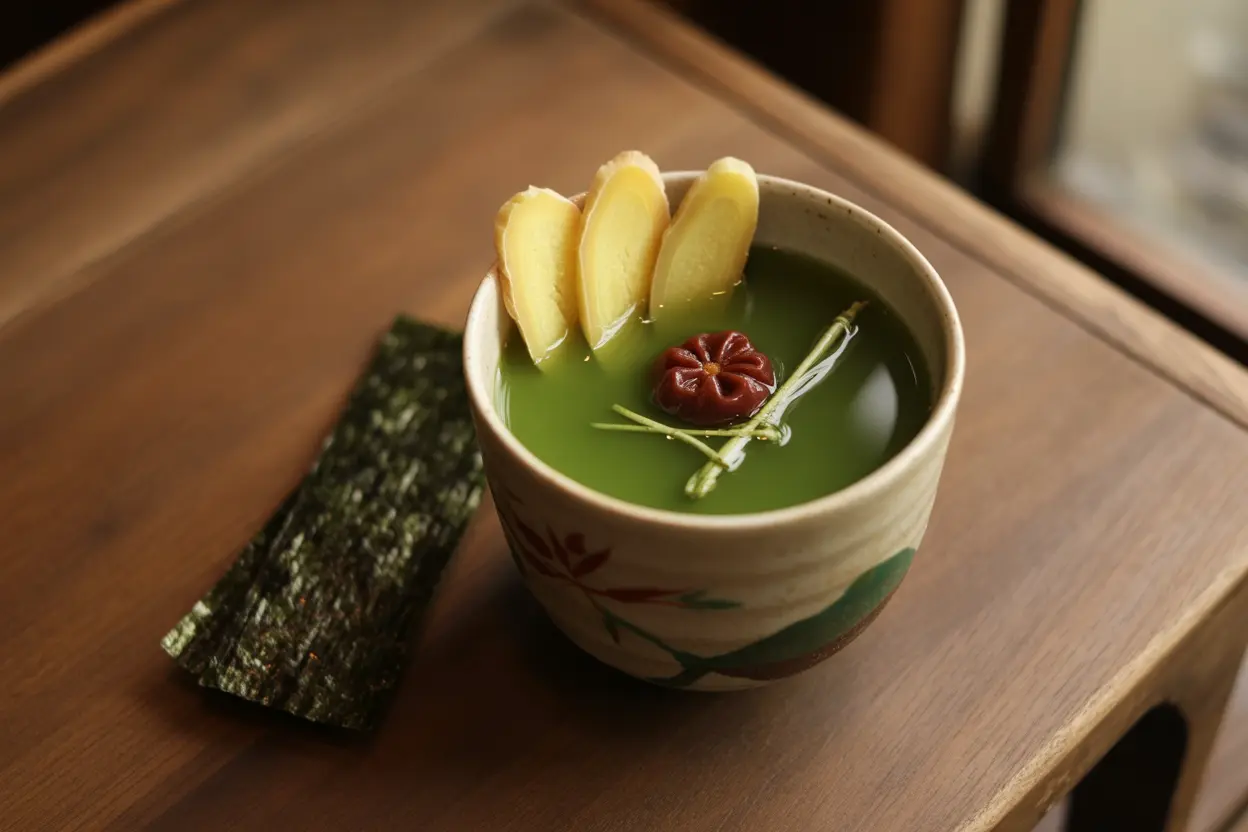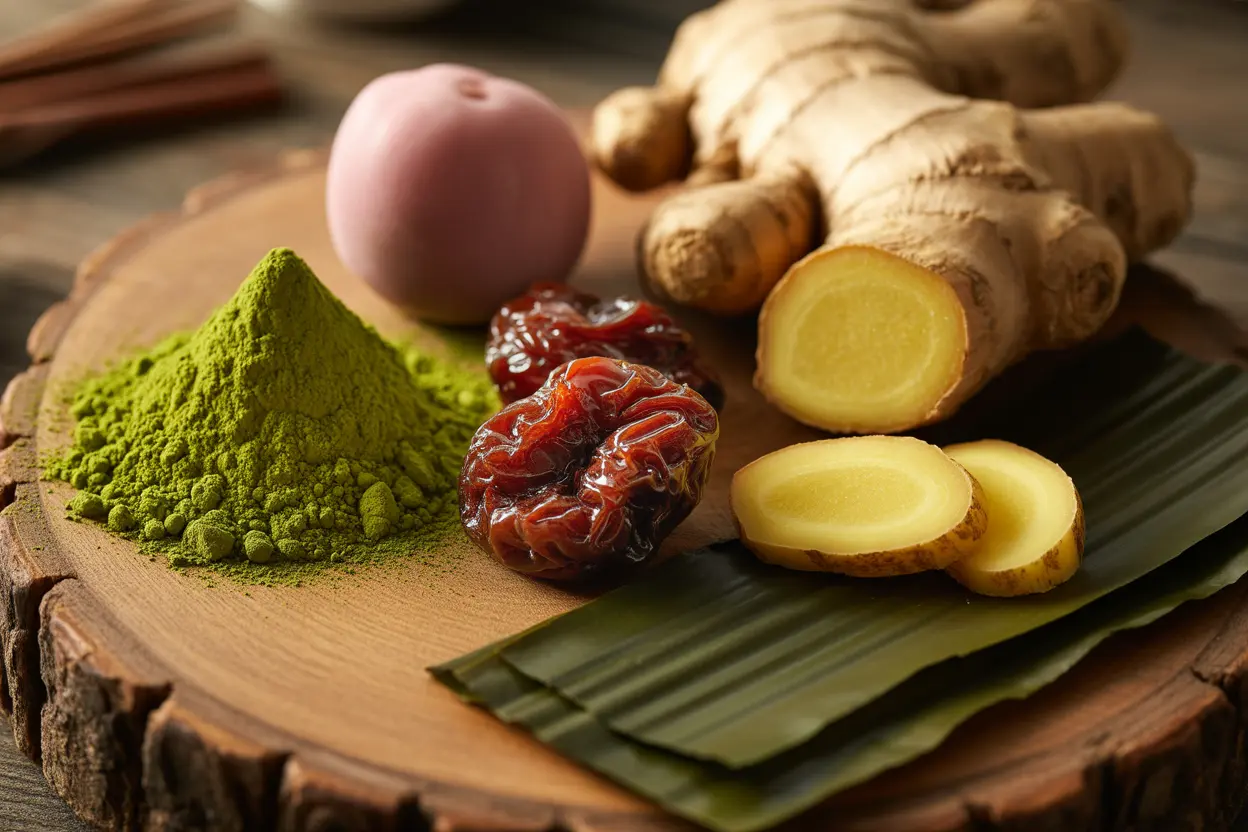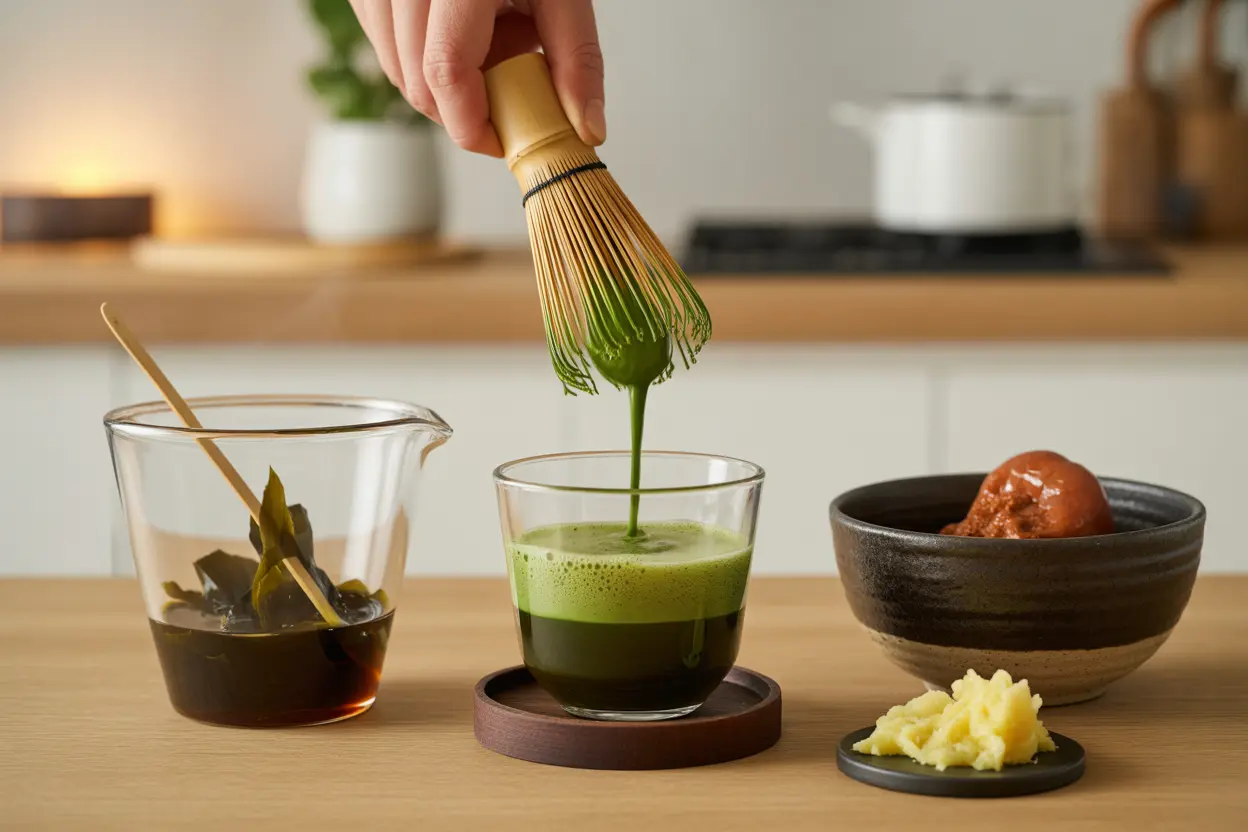Introduction to Japanese Mounjaro
What is Japanese Mounjaro?
Japanese Mounjaro is a traditional Japanese wellness drink celebrated for its unique blend of matcha green tea powder, umeboshi plum, fresh ginger, and kombu seaweed. This detox drink has gained popularity worldwide for its profound health benefits, notably as a natural metabolism booster and digestive aid. The allure of the Japanese mounjaro drink recipe lies in its harmonious balance of flavors and its ability to support holistic well-being. Curious about what makes this beverage a must-try? Unpacking its ingredients unveils a world of traditional Japanese culinary wisdom. For more on its foundational components, you might explore traditional wellness beverage ingredients.

Historical and Cultural Context
Rooted deeply in Japanese culinary culture, the Japanese mounjaro drink recipe is more than a beverage; it’s a ritual. Historically, it was crafted to harness the benefits of fermented Japanese plum alongside mineral-rich seaweed, promoting detoxification and energizing the body naturally. Over centuries, this drink has been revered in Japan as a morning tonic or a gentle digestive aid after meals. Its continued relevance speaks to its efficacy and the cherished place it holds within Japanese homes. To perfect your own rendition, check out step-by-step preparation method.
Core Ingredients of Japanese Mounjaro
Matcha Green Tea Powder
Matcha green tea powder is arguably the star of the Japanese mounjaro drink recipe. This finely ground powder is made from shade-grown tea leaves, delivering intense flavor and a vibrant green hue. Its potent antioxidant properties combat free radicals, aiding in slow down of aging and supporting overall health. Beyond antioxidants, matcha provides a gradual release of caffeine, making it an excellent energy booster without jitters. Incorporating this ingredient into the drink introduces a calm yet energizing effect. Not only is matcha revered in Japanese cuisine, but its inclusion in this recipe unlocks metabolic benefits well known across cultures. Surveys of core ingredient benefits highlight matcha’s efficacy when synergized with other components.
Umeboshi Plum or Umeboshi Paste
The umeboshi plum or its concentrated paste form brings a distinctive sourness that balances the drink’s earthiness. These fermented plums have been part of Japanese diets for centuries, prized for their digestive health contributions. Rich in citric acid, umeboshi acts as a natural detoxifier, supporting liver function and enhancing metabolism. When stirred into the Japanese mounjaro drink recipe, it adds layers of flavor and a tangy depth that complements the subtle bitterness of matcha. The plum’s probiotic qualities also boost gut flora, improving absorption of nutrients. For a detailed guide on ingredient options, explore variations and substitutions of ingredients.
Fresh Ginger
Fresh ginger injects a warm, spicy kick into this drink, activating circulation and aiding digestion. Known for its anti-inflammatory properties, ginger helps soothe the digestive tract and reduce nausea. In the Japanese mounjaro drink recipe, freshly grated ginger complements the other ingredients by initiating metabolism and providing a natural heat, both in flavor and effect. This root’s robustness supports cleansing processes in the body, making it a staple in natural detoxification recipes across cultures.
Kombu Seaweed
Kombu seaweed is a mineral-rich ingredient that infuses the drink with umami depth and essential nutrients such as iodine, calcium, and vitamins. Its inclusion links to traditional Japanese health teas and detoxifying drinks. Steeping kombu releases natural glutamates, enhancing flavor while supporting thyroid function and digestion. The seaweed’s natural minerals make the drink not only tasty but also remineralizing, a vital aspect of many traditional detox ingredients. Learning the correct steeping technique can be found in the step-by-step preparation method.
Warm Water and Its Importance
Using warm water is critical in the Japanese mounjaro drink recipe as it helps gently extract flavors and nutrients from kombu and matcha without bitterness. Warm water ensures the kombu infusion releases minerals slowly, preserving delicate enzymes. It also allows umeboshi and ginger flavors to meld seamlessly, creating a balanced drink. Cold water would dull these effects and alter both taste and health benefits. Understanding water temperature nuances elevates the drink from simple beverage to a mindful ritual.

For more on crafting an authentic digestive health drink, consider reading the comprehensive guide at Japanese Mounjaro Recipe: Authentic Digestive & Weight Loss Drink.
Optional and Modern Variations in Ingredients
Citrus Elements: Lemon Juice and Yuzu Peel
Adding lemon juice or yuzu peel introduces a fresh, zesty brightness to the classic Japanese mounjaro drink recipe. These citrus elements heighten the drink’s detoxifying and metabolism-boosting properties by providing extra vitamin C and aromatic oils. Lemon juice’s acidity further balances the sweet-sour profile, enhancing digestion and cleansing. Yuzu, a traditional Japanese citrus, adds a floral, complex twist that harmonizes beautifully with ginger and umeboshi. These modern touches offer a tangy lift without overpowering the foundational flavors.
Natural Sweeteners: Raw Honey and Maple Syrup
For those craving a subtle sweetness, raw honey or maple syrup are perfect natural sweeteners to incorporate. Unlike refined sugars, these choices complement the drink’s healthful nature, offering antioxidants and trace minerals. Raw honey especially pairs well with the spicy warmth of ginger and the umami of kombu, enhancing the antioxidant properties while soothing the palate. These sweeteners align with the aim of crafting a nourishing, not overly sugary, beverage, adhering to the drink’s role as a natural metabolism booster.
Additional Boosters: Daikon Radish, Turmeric, Miso, and Shio-Koji
To amplify the wellness quotient, some recipes add daikon radish for digestive enzyme support or turmeric for its powerful anti-inflammatory effects. Meanwhile, fermented ingredients like miso paste and shio-koji introduce probiotics and a savory depth to the drink. These components deepen both flavor and functionality, bridging ancient tradition with contemporary superfood trends. Incorporating these can customize the drink for specific health goals, making it a versatile tonic in the natural weight loss guide realm. Learn more about these optional and additional ingredients.
Other Contemporary Ingredients: Chia Seeds, Mint, Apple Cider Vinegar
Modern twists sometimes include chia seeds for fiber and omega-3, fragrant mint leaves for freshness, or a splash of apple cider vinegar to edge up tanginess and acidity. These additions enhance digestive health and introduce a refreshing or textural contrast. Apple cider vinegar, renowned in diet circles, supports natural detoxification and complements the plum’s fermentative properties. These elements offer creative avenues to adapt the Japanese mounjaro drink recipe to diverse palates and wellness preferences.
Preparation Method of Japanese Mounjaro
Steeping Kombu in Warm Water
Begin your Japanese mounjaro drink recipe by gently soaking a strip of dried kombu seaweed in warm water—ideally around 140°F or 60°C. This slow steeping releases minerals and umami essence without bitterness. Avoid boiling to preserve delicate nutrients. After 10-15 minutes, remove the kombu, leaving behind a clear, mineral-rich broth that forms the base of your drink. This step crafts the necessary kombu infusion, a cornerstone of the recipe’s unique flavor.
Whisking Matcha Powder
Next, sift a teaspoon of matcha green tea powder into a bowl and add a small amount of warm water. Using a bamboo whisk, vigorously mix until you achieve a frothy, vibrant green liquid. This technique prevents clumps, promoting a smooth texture essential for the drink’s consistency. Whisking in this traditional way preserves matcha’s full antioxidant properties and ensures the right balance of flavor and mouthfeel, a critical step detailed in recipe preparation tips.
Combining Umeboshi and Grated Ginger
In a separate container, mash or stir in a small amount of umeboshi paste with freshly grated ginger. This mixture brings pungent, tangy sharpness and warming spice to the drink, activating digestive enzymes and metabolism naturally. Their combination complements the smoothness of the matcha and the mineral-rich kombu broth.
Mixing and Final Adjustments
Finally, blend all components—the kombu infusion, whisked matcha, and umeboshi-ginger paste—into a single vessel. Stir thoroughly to create a harmonious blend. Optional sweeteners or citrus can now be added to taste. Adjust temperature as desired; typically, this drink is best enjoyed warm to maximize health benefits. This last step seals the recipe, transforming raw ingredients into a revitalizing, natural metabolism booster that offers a sensory and wellness experience. For more inspiration, check out our step-by-step sandwich guide as an example of precise preparation techniques.

Health Benefits of the Ingredients in Japanese Mounjaro
Metabolic and Digestive Benefits
The Japanese mounjaro drink recipe shines as a potent weight loss beverage and digestive tonic. Ingredients like umeboshi plum, fresh ginger, and daikon radish work synergistically to enhance digestive enzymes, detoxify the liver, and stimulate metabolism. Ginger activates digestion and circulation, while umeboshi’s citric acid aids liver detoxification. The kombu seaweed infusion provides minerals vital for thyroid function, indirectly boosting metabolic rate. Together, these elements encourage efficient calorie burning and smooth gastrointestinal function, making the drink a favorite in traditional and modern Japanese dietary drink routines. Studies highlighting metabolic and digestive advantages affirm this synergy.
Antioxidant and Anti-inflammatory Properties
Beyond metabolism, the drink is an antioxidant powerhouse, primarily due to matcha green tea powder and turmeric. Matcha delivers high concentrations of catechins, especially EGCG, which neutralize harmful free radicals. Turmeric adds curcumin, a potent anti-inflammatory agent that combats chronic inflammation linked to various diseases. Fresh ginger also contributes important anti-inflammatory effects. Collectively, these ingredients help reduce oxidative stress and support immune health, providing a natural defense system to the body. This role in Japanese health teas has paved the way for the drink’s increasing acceptance in wellness communities worldwide.
Additional Wellness Benefits From Optional Ingredients
Incorporating optional elements like raw honey, shio-koji, or apple cider vinegar introduces additional health boosters. Raw honey soothes inflammation and offers antibacterial properties; shio-koji supplies beneficial enzymes supporting gut health; apple cider vinegar aids in blood sugar regulation and digestion. Even chia seeds escalate fiber content, promoting satiety and heart health. These modern twists do not stray from the recipe’s traditional healing roots but instead enhance its comprehensive wellness profile.
To explore these benefits in food context, our classic French sandwich recipes article nicely complements understanding of ingredient synergy.
Common Uses and Consumption Practices
When to Consume Japanese Mounjaro
Many enjoy Japanese mounjaro as a morning detox drink, kickstarting metabolism and mental clarity with the mild caffeine from matcha and warming ginger. Others consume it post-meal to aid digestion and reduce bloating. It’s also popular during transitional seasons to help the body cleanse and rebalance. Integrating this beverage into daily routines aligns with its detoxifying and metabolism-boosting properties. Curious about simplifying your intake? Discover the four-ingredient wellness recipe for a quick approach.
Serving Suggestions and Flavor Enhancements
While traditionally consumed warm, some prefer serving Japanese mounjaro chilled during warmer months. Adding a twist of yuzu peel or a drizzle of raw honey can enhance flavor and health qualities. Pairing this drink with light meals or snacks helps absorption and offers balanced nourishment. Its flavor complexity suits those who appreciate layered tastes: earthy, tangy, spicy, and umami, all in one cup.
Cultural and Dietary Contexts
The drink resonates well with Japanese traditional ingredients and fits neatly into varied diets, including vegan, gluten-free, and detox programs. Owing to its low calorie count and nutrient density, it’s a favored choice among health-conscious individuals seeking a natural metabolism booster. Embracing Japanese mounjaro means embracing a piece of Japanese wellness and culinary culture that respects nature’s gifts and mindful preparation.
For more ideas on simple health drinks, our homemade mounjaro drink recipe: natural weight loss guide is a great resource.
Popular Myths and Facts About Japanese Mounjaro Ingredients
Debunking Common Misconceptions
There’s a myth that Japanese mounjaro is a magical cure-all. While it offers impressive health benefits, it’s not a substitute for a balanced diet or medical treatments. Another misconception is that umeboshi plum is overly sour and unpleasant; however, when properly diluted in the recipe, it adds gentle tanginess that harmonizes with matcha and ginger. Some believe kombu’s iodine might be excessive, but when consumed moderately as in this recipe, it safely supports thyroid health without risk. Understanding these nuances helps avoid false expectations.
Scientific Evidence and Current Research
Current research supports many claims surrounding the Japanese mounjaro drink recipe. Studies emphasize matcha’s capacity to enhance metabolism and provide antioxidants. Umeboshi’s fermentative qualities are linked with improved gut health and natural detoxification. Ginger and turmeric boast anti-inflammatory and digestive benefits validated by clinical trials. The combined effect of these ingredients creates a holistic wellness drink consistent with traditional usage and modern science. For a deeper dive into the health benefits and weight loss support, visit polarbearmeds.com.
FAQs
What is the main ingredient in Japanese Mounjaro?
The main ingredient is matcha green tea powder, which provides antioxidants and a gentle caffeine boost. It pairs with umeboshi plum for detoxification and kombu seaweed for minerals, all combined with fresh ginger to enhance digestion.
Can I substitute any ingredients in Japanese Mounjaro?
Yes, you can swap umeboshi paste with plain umeboshi or adjust sweeteners like opting for raw honey or maple syrup instead. Some also include modern twists like turmeric or apple cider vinegar for extra benefits.
What are the health benefits of Japanese Mounjaro?
It supports metabolism, digestion, and detoxification, providing antioxidant support and anti-inflammatory effects, mainly due to matcha, ginger, and umeboshi plum.
How is Japanese Mounjaro traditionally prepared?
It involves steeping kombu in warm water, whisking matcha finely, mashing umeboshi plum with grated ginger, then combining everything into a warm, nourishing beverage.
Is Japanese Mounjaro suitable for daily consumption?
Yes, it can be consumed daily as part of a balanced diet, especially for boosting metabolism and digestive health, but it should complement, not replace, a varied diet.
Conclusion
Japanese Mounjaro is a Japanese traditional ingredient-based wellness drink that masterfully blends matcha green tea, umeboshi plum, kombu seaweed, and fresh ginger. This thoughtfully combined recipe not only highlights the detoxifying and metabolism-boosting properties of its components but also offers a sensory experience rooted in Japanese culinary culture. Optional modern ingredients like lemon juice and raw honey allow for customization while preserving the authentic essence. Understanding these core and additive ingredients empowers you to incorporate this nourishing, natural metabolism booster into your daily routine. Whether you stick to the classic or try creative adaptations, Japanese Mounjaro remains a timeless beacon of holistic health.
For more on authentic recipes and health guidance, visit Japanese Mounjaro Recipe: Authentic Digestive & Weight Loss Drink.
